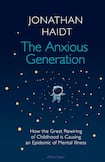
No. I would not let my first child, just turned 10, move to Mars at the request of a “visionary billionaire who ... does not seem to know anything about child development and [doesn’t] seem to care about children’s safety”.
Nonetheless, it’s perfectly appropriate for this precious child of mine to open a TikTok or Instagram account, despite each having been intentionally designed to exploit the psychological and neurobiological vulnerabilities of preteen and teen girls. These are girls whose frontal cortices have not yet fully matured and are not equipped to resist the endless novelty and social rewards of a world governed by likes, comments and retweets.
Though the first outlandish scenario is a “completely insane idea”, the second is a ubiquitous, some might think necessary, compromise. Throughout The Anxious Generation, social scientist Jonathan Haidt invokes the image of sending our kids to Mars – an environment for which they are tragically ill-adapted – as a metaphor for handing our kids a smartphone, a constantly vibrating portal into a world of online pornography, video games and addictive social media apps.
It was just such a portal, coupled with the advent of social media and the iPhone, according to Haidt, that accounts for the unprecedented rise in anxiety and depression among boys and girls born after 1995 (ie, Gen Z or the “Anxious Generation”) during the 2010s. That and the emergence of a culture of parental overprotection or “safetyism” a couple of decades prior.
Throughout the book, Haidt flits in and out of multiple roles to great effect – the teacher, the social scientist, the father of two smartphone-hooked teens. However, arguably his most enthralling chapters are those where he dons his scientist’s cap. He starts with a bang, deftly revealing why the current youth mental health crisis defies explanation by any other popular theory. Not only does he demonstrate that similar trends repeat all over the anglosphere, but he also explains why this crisis is unlikely to result from overzealous self-diagnosis or over-diagnosis (ie, the “prevalence inflation” hypothesis), as suggested by several Oxford University-based researchers.
While Haidt is meticulous about presenting the hard facts, he also reminds us that our kids are being trained like “rats during their most sensitive years of brain rewiring”. Adding persuasive sauce to his arguments, Haidt elicits outrage in the reader with his references to leaked internal documents which prove that Facebook were not only aware of preteen and teen neurobiological vulnerabilities but actively hijacked them to create self-reinforcing habit loops.
Some of Haidt’s emotive assertions carry the risk of sounding less like the words of a serious scientist than those of a sensational headline. Yet, with evidence that appears to bolster his side of the argument so unequivocally, Haidt gets away with it. He shows, in his characteristically systematic way, that addiction is just one of “four foundational harms” – the others being social deprivation, sleep deprivation and attention fragmentation – wreaked by the new phone-based childhood on boys and girls.
More broadly, Haidt invites us to consider the many harms of the Great Rewiring in terms of the “opportunity cost” of near total immersion in a virtual world. In doing so, the social scientist argues that Gen Z have been living according to a new digitised cultural script, emerging around the 2010s, which deprives them of those critical brain-shaping experiences of the “play-based childhood”.
These are experiences that have, for millenniums, served as the foundation of a necessary kind of social and cultural learning that depended on a number of real-world conditions: our physicality as embodied creatures, our synchronism as tribes who move together and take turns, our “anti-fragility” as mammals strengthened through carefully titrated risk-taking and unsupervised rough-and-tumble play, and our rootedness within communities where we must invest time and effort in building and repairing lasting relationships.
With teens spending upwards of six to eight hours per day on all screen-based leisure activities, Haidt forces us to interrogate the losses that many of us have looked upon with nonchalance. These include the erosion of steadfast communities, of rites of passage that supply the transition from childhood to adulthood with meaningful structure and a sense of graduated independence, and of screen-free spaces allowing for uninterrupted sleep, classroom learning and even the kind of nature-induced awe that leads to spiritual “elevation”.
In the latter half of the book, Haidt lays out a number of potential solutions to the current crisis, all of which depend upon collective action: no smartphones before high school (roughly age 14), no social media before 16, phone-free schools and “far more unsupervised play and childhood independence”.
In a clever return to the opening imagery of the inhospitable planet Mars, Haidt closes with a final call to action which, though it may seem irresistible on the surface, is likely to prove far more difficult to implement in practice: “Let’s bring our children home.”














